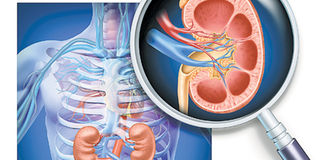Wilms tumour: A little-known childhood kidney cancer in Tanzania

What you need to know:
- It’s also known as Wilms tumour, because it was first described by a German surgeon, Dr Max Wilms, more than 100 years ago.
- Dr Shakilu Jumanne, a Paediatric Oncologist in Dar es Salaam, has once told Your Health that Wilms tumour is among the childhood cancer cases that are reported every year at Muhimbili National Hospital (MNH).
Today, let’s talk about cancer of the kidneys—a malignancy that’s common in children but rarely affecting adults.
It’s also known as Wilms tumour, because it was first described by a German surgeon, Dr Max Wilms, more than 100 years ago.
Dr Shakilu Jumanne, a Paediatric Oncologist in Dar es Salaam, has once told Your Health that Wilms tumour is among the childhood cancer cases that are reported every year at Muhimbili National Hospital (MNH).
Using data reported from MNH’s Paediatric Oncology ward, Dr Jumanne said Wilms tumour ranks third after other childhood malignancies, leukaemia (blood cancer) and lymphoma (cancer of lymph nodes).
What causes Wilms tumour?
Experts do not know what the exact cause of Wilms’ tumour is. Most agree that the cancer probably starts when the baby is still in the womb, when some supposed kidney cells do not develop properly. The abnormal cells multiply in their primitive state and become a tumour, which is usually detectable at the age of 3 to 4 years, according to Medical News Today.
Both current and former smokers have an increased risk of kidney cell cancer compared to people who have never smoked, according to World Cancer Research Fund International.
Like the rest of Africa, Wilms tumour cases in Tanzania are underreported—data is scarce, for that matter.
According to World Atlas, countries with the highest incidences of kidney cancer are; The Czech Republic, Lithuania, and Slovakia.
Data further shows that cancer of the kidney is the twelfth most prevalent cancer in the world today with an estimated 338,000 new cases diagnosed annually.
In countries where extensive research has been done, Wilms tumour is known to affect approximately 10 children and adolescents per 1 million before the of age 15 years.
In Tanzania, the very well-known fact about people affected by Wilms tumour is that they have little access to treatment due to poverty and government’s little investment in childhood cancers.
This is, despite oncologists saying that Wilms tumour is highly responsive to treatment. About 90 per cent of patients survive at least five years.
Symtoms
The first sign that characterises a patient—mostly a child with Wilms tumour—is a painless abdominal swelling that can be easily felt by the doctor when examining the patient.
But according to a popular medical portal, Medscape, the symptoms of Wilms tumour include:
• Asymptomatic abdominal mass (in 80 per cent of children when seen by the doctor for the first time.
• Abdominal pain or blood in urine
• Urinary tract infection (UTIs)
• High blood pressure, fever (in 5-30 percent of cases)
• Low blood pressure and anaemia
• Respiratory symptoms in patients with advanced disease but this is a rare situation
After identifying those symptoms in a patient, an ultrasound scan, computed tomography scan, or MRI scan is done.
Like in most cancers, one would have expected the next procedure to be obtaining a biopsy---a tissue which is sliced from the kidney tumour for diagnosis.
However, this is usually not done due to fears that the process can create fragments of cancer tissue and “smear” the abdomen with cancerous cells.
Treatment choices vary depending on the type and stage of cancer, the possible side effects, and what the patient prefers.
The first stage of the cancer is mostly treated by surgery. According to standards of treatment, the affected kidney can be surgically removed—a procedure known as nephrectomy. This is followed by chemotherapy treatment.
Sometimes, chemotherapy may come first.




